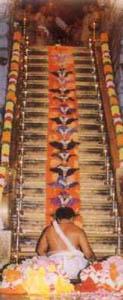|
Inchipparakota :
The next important place is the
Inchipparakota where there is Kotayil Sastha shrine. Pilgrims
offer prayers here and break coconuts. From here the pilgrims
descent the slippery path carefully. The descent ends at Karimala
thodu (canal) with Azhutha hill on one side and Karimala hill
on the other. Pilgrims rest here for a while.
Swamyin
Dharishaname Saranam Ayyappa !
 According
to legend, the temple of Sabarimala and the deity of Ayyappa have
always been regarded as the Pandalam Raja's very own, and it is
not considered proper to proceed to the temple without the king's
knowledge and permission. To make it easy for pilgrims to obtain
the necessary permission, a representative of the king sits even
today, with all the royal insignia, on a raised platform at the
base of the Neelimala Hill. The pilgrims offer a token amount
to the royal representative, and receive vibhuti from him. According
to legend, the temple of Sabarimala and the deity of Ayyappa have
always been regarded as the Pandalam Raja's very own, and it is
not considered proper to proceed to the temple without the king's
knowledge and permission. To make it easy for pilgrims to obtain
the necessary permission, a representative of the king sits even
today, with all the royal insignia, on a raised platform at the
base of the Neelimala Hill. The pilgrims offer a token amount
to the royal representative, and receive vibhuti from him.
This marks
the beginning of the steepest climb of the pilgrimage, the 3 km
trek up the majestic Neelimala Hill, atop which sits Lord Ayyappa
in all his glory. The pilgrims wind their way up the difficult
trail in an unending stream, the hill reverberating with the constant
chanting of thousands.
At the first
sight of the Patinettampadi, the holy eighteen steps, a full throated
cry goes up from the devotees, "Swamiye Saranam Ayyappa!"
It is the realisation of a mission.
 Built
on a plateau about 40 feet high, the Ayyappan temple commands
a lofty view of the mountains and valleys all around. The ancient
temple has been rebuilt after a fire in 1950, consisting of a
sanctum sanctorum with a copper-plated roof and four golden finials
at the top, two mandapams, the belikalpura which houses the altar,
and the flag-staff. Replacing the earlier stone image of the deity
is a beautiful idol of Ayyappa in panchaloha, an alloy of five
metals, about one and a half feet tall. Built
on a plateau about 40 feet high, the Ayyappan temple commands
a lofty view of the mountains and valleys all around. The ancient
temple has been rebuilt after a fire in 1950, consisting of a
sanctum sanctorum with a copper-plated roof and four golden finials
at the top, two mandapams, the belikalpura which houses the altar,
and the flag-staff. Replacing the earlier stone image of the deity
is a beautiful idol of Ayyappa in panchaloha, an alloy of five
metals, about one and a half feet tall.
There are several explanations regarding the significance of the
Patinettampadi, but in all of them, the emphasis is on the number
18. One popular belief is that the first 5 steps signify the five
indriyas or senses, the next 8 the ragas, the next 3 the gunas,
followed by vidya and avidya. Crossing these would take the devotee
closer to self-realisation.
Finally, at the eighteenth step, the devotee is at last face to
face with the image of the Lord Ayyappa, or Dharma Sasta. A circumambulation
brings him right in front of the sanctum sanctorum, and the pilgrim
is filled with a sense of accomplishment and utter peace. But
there is one more thing to be done - the ghee abhisheka, or bathing
of the idol in ghee, which marks the culmination of the pilgrimage.
The ghee-filled coconut which the pilgrim has carried in the front
section of his irumudi is broken, and the ghee is offered to the
deity. Another important abhisheka is of vibhuti, which is also
brought by the devotee in his irumudi.
|